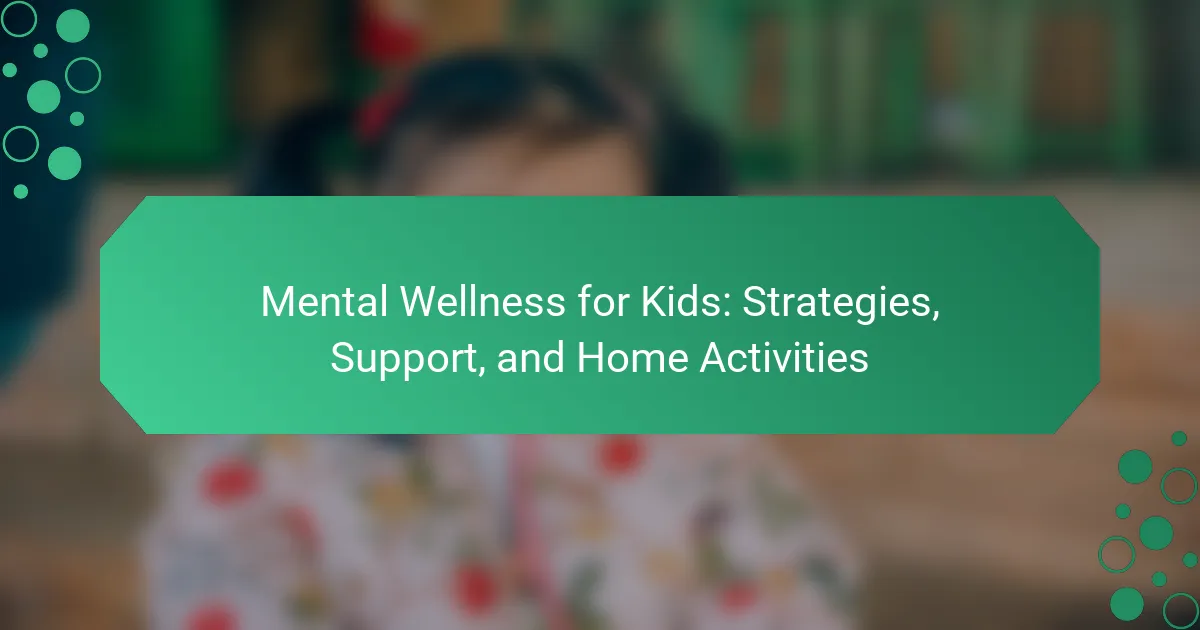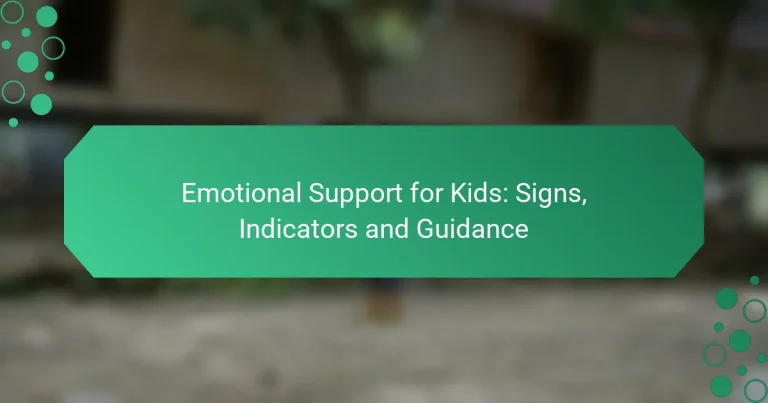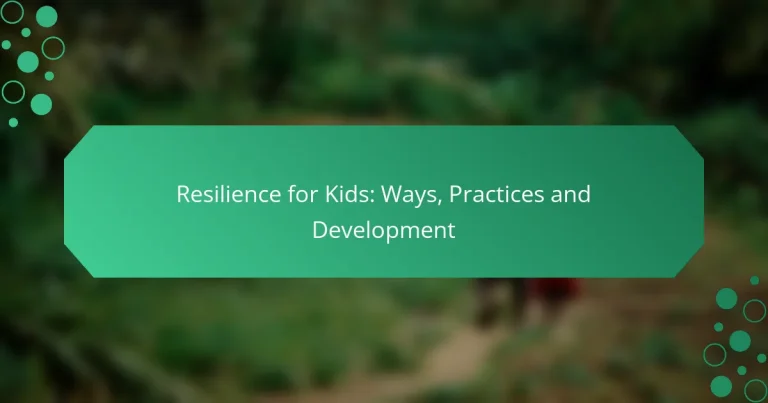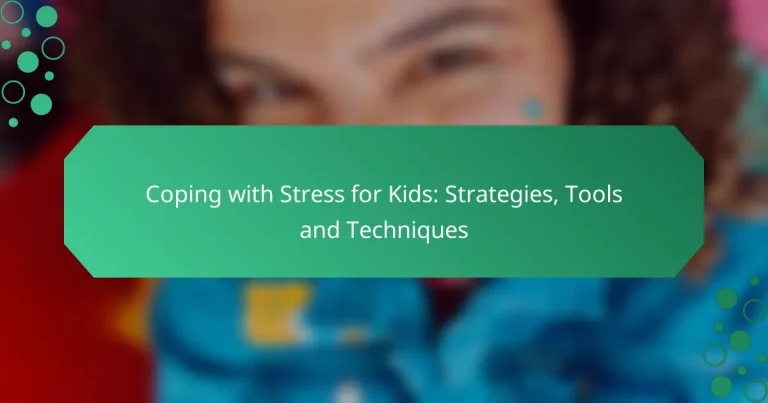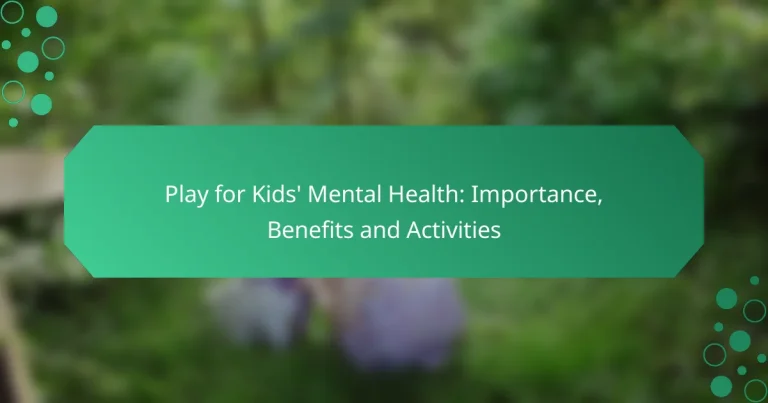Mental Wellness for Kids: Strategies, Support, and Home Activities
Promoting mental wellness in kids is essential for their emotional health and resilience. By implementing effective strategies and fostering a supportive home environment, parents can help children develop coping skills and a positive mindset. Engaging in creative and connection-focused activities at home can further enhance their mental well-being, ensuring they feel safe and supported in expressing their feelings.

What Are Effective Mental Wellness Strategies for Kids?
Effective mental wellness strategies for kids include activities and practices that promote emotional health, resilience, and coping skills. These strategies can help children manage stress, express themselves, and develop a positive mindset.
Mindfulness exercises
Mindfulness exercises help children focus on the present moment, reducing anxiety and improving emotional regulation. Simple practices like deep breathing, body scans, or guided imagery can be incorporated into daily routines.
Parents can introduce mindfulness through short sessions, starting with just a few minutes each day. Apps or online resources designed for kids can provide engaging guided practices.
Creative expression through art
Artistic activities allow children to express their feelings and thoughts in a non-verbal way, fostering emotional release and creativity. Drawing, painting, or crafting can serve as therapeutic outlets for stress and anxiety.
Encourage kids to create art without the pressure of perfection. Setting aside time for free expression can lead to discoveries about their emotions and enhance their overall mental wellness.
Physical activity and outdoor play
Physical activity is crucial for mental health, as it releases endorphins that improve mood and reduce stress. Outdoor play, in particular, connects children with nature, which has additional calming effects.
Encourage at least 30 minutes of physical activity most days, whether through organized sports, biking, or simply playing outside. This not only promotes fitness but also enhances social skills and teamwork.
Structured routines
Structured routines provide children with a sense of security and predictability, which can reduce anxiety. Establishing regular schedules for meals, homework, and bedtime helps children know what to expect throughout the day.
Involve kids in creating their routines to foster a sense of ownership. Use visual schedules or charts to make the routine engaging and easy to follow.
Positive reinforcement techniques
Positive reinforcement encourages desired behaviors by rewarding children for their efforts and achievements. This can boost their self-esteem and motivate them to continue engaging in positive actions.
Use specific praise, rewards, or privileges to reinforce good behavior. Setting achievable goals and celebrating small successes can create a positive feedback loop that enhances mental wellness.

How Can Parents Support Their Children’s Mental Health?
Parents can support their children’s mental health by fostering a nurturing environment that emphasizes open communication, active listening, and positive role modeling. These practices help children feel safe to express their feelings and develop healthy coping mechanisms.
Open communication practices
Establishing open communication practices involves creating a safe space for children to share their thoughts and feelings without fear of judgment. Regularly check in with your child about their day, emotions, and any challenges they may face. Use age-appropriate language and encourage them to express themselves freely.
Consider setting aside time each week for a family discussion or activity that promotes sharing. This could be during dinner or a designated family night, allowing everyone to contribute and feel heard.
Active listening skills
Active listening is crucial for understanding your child’s needs and emotions. When your child speaks, give them your full attention, maintain eye contact, and respond appropriately to show that you value their input. Avoid interrupting or jumping to conclusions before they finish sharing.
To enhance active listening, reflect back what your child says to confirm understanding. Phrases like “It sounds like you’re feeling…” can help validate their feelings and encourage further dialogue.
Encouraging social interactions
Encouraging social interactions is vital for children’s emotional development. Facilitate opportunities for your child to engage with peers through playdates, group activities, or community events. These interactions help them build friendships and develop social skills.
Be mindful of your child’s comfort level with social situations. Gradually introduce them to new environments and people, and provide support as they navigate these experiences. Encourage participation in team sports or clubs that align with their interests.
Setting a positive example
Parents can set a positive example by demonstrating healthy emotional regulation and coping strategies. Show your child how you manage stress through activities like exercise, mindfulness, or talking about your feelings. Children often model their behavior after their parents, so being mindful of your reactions is essential.
Share your own experiences with challenges and how you overcame them. This transparency can help children understand that it’s normal to face difficulties and that seeking help is a strength, not a weakness.

What Home Activities Promote Mental Wellness?
Engaging in home activities that promote mental wellness can significantly benefit children’s emotional and psychological health. Activities that foster connection, creativity, and healthy habits are particularly effective in supporting kids’ mental well-being.
Family game nights
Family game nights create an opportunity for bonding and fun, which are essential for mental wellness. Playing board games or card games encourages teamwork, communication, and problem-solving skills.
To make the most of game nights, choose games that are age-appropriate and involve everyone. Consider rotating game choices to keep things fresh and exciting, ensuring that each family member has a chance to share their favorites.
Gardening together
Gardening together allows children to connect with nature while learning responsibility and patience. This hands-on activity can be therapeutic and offers a sense of accomplishment as plants grow and flourish.
Start with easy-to-grow plants or vegetables, which can be rewarding for kids. Set aside a small area in your yard or use pots if space is limited. Involving children in the entire process, from planting to harvesting, enhances their engagement and enjoyment.
Cooking healthy meals
Cooking healthy meals as a family promotes nutrition awareness and encourages teamwork. Involving kids in meal preparation can help them develop cooking skills and a better understanding of healthy eating habits.
Choose simple recipes that allow children to participate actively, such as making smoothies, salads, or homemade pizzas. Discuss the nutritional benefits of the ingredients used, fostering a positive relationship with food.
Reading together
Reading together enhances literacy skills while providing a cozy bonding experience. This activity allows children to explore new worlds and ideas, which can stimulate their imagination and emotional intelligence.
Set aside a regular reading time where everyone can enjoy their books, or take turns reading aloud from a shared book. Discuss the stories afterward to encourage critical thinking and connection to the material.

What Are the Signs of Mental Health Issues in Kids?
Recognizing the signs of mental health issues in kids is crucial for early intervention and support. Common indicators include noticeable changes in behavior, withdrawal from activities, difficulty concentrating, and alterations in sleep patterns.
Changes in behavior
Behavioral changes can manifest as increased irritability, mood swings, or aggression. For instance, a child who was once friendly may become easily frustrated or angry over minor issues. Parents should observe if these changes persist over weeks, as they may signal underlying mental health concerns.
It’s essential to differentiate between typical developmental changes and concerning behavior. If a child exhibits drastic shifts in their usual conduct, it may be time to seek professional advice.
Withdrawal from activities
Withdrawal from previously enjoyed activities can indicate emotional distress. If a child suddenly loses interest in sports, hobbies, or socializing with friends, it may be a sign of mental health issues. This disengagement often stems from feelings of sadness or anxiety.
Parents should encourage open conversations about these changes and gently prompt their children to participate in activities they once enjoyed. Maintaining a supportive environment can help children feel more comfortable expressing their feelings.
Difficulty concentrating
Struggling to concentrate can affect a child’s academic performance and daily tasks. Signs include frequent distractions, trouble completing homework, or difficulty following instructions. These issues may arise from anxiety, depression, or other mental health challenges.
To support concentration, establish a structured routine and minimize distractions at home. Simple techniques like breaking tasks into smaller steps can also help children manage their workload more effectively.
Changes in sleep patterns
Changes in sleep patterns, such as insomnia or excessive sleeping, can be indicative of mental health problems. A child who has trouble falling asleep or frequently wakes during the night may be experiencing anxiety or stress. Conversely, oversleeping can signal depression.
Monitoring sleep hygiene is vital. Encourage a consistent bedtime routine and create a calming sleep environment. If sleep issues persist, consulting a healthcare professional may be necessary to address potential underlying mental health concerns.

How Can Schools Contribute to Mental Wellness?
Schools play a crucial role in promoting mental wellness among students by creating supportive environments and implementing effective programs. By integrating mental health education and resources, schools can help children develop coping skills and resilience.
Creating a Supportive Environment
A supportive school environment fosters emotional safety and encourages open communication. Schools can achieve this by training staff to recognize signs of mental distress and providing resources for students to seek help. Regular check-ins and supportive peer networks can significantly enhance students’ sense of belonging.
Implementing Mental Health Programs
Schools should implement mental health programs that include workshops, counseling services, and stress management activities. Programs like mindfulness training or social-emotional learning can equip students with essential skills to handle challenges. Engaging parents and the community in these initiatives can further strengthen support systems.
Training Staff and Educators
Training teachers and staff on mental health awareness is vital for early intervention. Educators should be familiar with mental health resources and referral processes to assist students effectively. Regular professional development can ensure that staff remain informed about best practices in supporting mental wellness.
Encouraging Open Communication
Encouraging open dialogue about mental health reduces stigma and promotes understanding. Schools can host events or workshops that focus on mental wellness topics, allowing students to share experiences and learn from one another. Creating safe spaces for discussion can empower students to express their feelings and seek help when needed.
